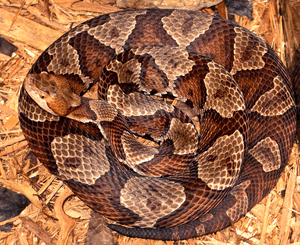Northern copperhead snake facts for kids
Quick facts for kids Agkistrodon contortrix mokasen |
|
|---|---|
 |
|
| Scientific classification |
|
| Kingdom: | Animalia |
| Phylum: | Chordata |
| Class: | Reptilia |
| Order: | Squamata |
| Suborder: | Serpentes |
| Family: | Viperidae |
| Genus: | Agkistrodon |
| Species: | |
| Subspecies: |
A. c. mokasen
|
| Trinomial name | |
| Agkistrodon contortrix mokasen Palisot de Beauvois, 1799
|
|
| Synonyms | |
|
|
The northern copperhead snake (Agkistrodon contortrix mokasen) is a type of snake found in the eastern United States. It's one of five different kinds, or subspecies, of the copperhead snake. These snakes are known for their unique patterns and their important role in nature.
Contents
About the Northern Copperhead
Northern copperheads are medium-sized snakes. They usually grow to be about 2 to 3 feet (60 to 90 cm) long. Some can even reach up to 4 feet (1.2 meters). They have a sturdy body and a head that is wider than their neck.
What Do They Look Like?
These snakes are famous for their beautiful patterns. Their skin is usually a light brown, tan, or pinkish color. They have darker, reddish-brown bands shaped like an hourglass or a dumbbell across their back. These bands are wider on the sides and narrower in the middle of their back. This pattern helps them blend in perfectly with fallen leaves and dirt on the forest floor.
Their heads are often a coppery-red color, which is how they got their name. Young copperheads have a bright yellow or greenish-yellow tip on their tail. This bright tail tip helps them to attract prey.
Where Do Northern Copperheads Live?
Northern copperheads live in many different places across the eastern United States. You can find them from southern New England all the way down to northern Georgia and Alabama. They also live west to Illinois and Missouri.
They prefer to live in wooded areas, especially those with rocky hillsides and forests near streams or rivers. They can also be found in swamps, farmlands, and even suburban areas. They like places where they can find good hiding spots, like under logs, rocks, or piles of leaves.
Life and Habits of Copperheads
Northern copperheads are mostly active during the day in spring and fall. When summer gets very hot, they become more active at night. This helps them avoid the extreme heat.
What Do Copperheads Eat?
Northern copperheads are carnivores, meaning they eat other animals. Their diet mainly includes small rodents like mice and voles. They also eat small birds, lizards, and even large insects like cicadas. Young copperheads use their bright tail tip to wiggle and attract frogs or small lizards.
They are ambush predators. This means they wait quietly for their prey to come close. Then, they strike quickly to catch their meal.
How Do They Behave?
Copperheads are generally shy snakes. They prefer to avoid people and will usually try to escape if they feel threatened. When they feel scared, they might freeze in place. Their camouflage helps them disappear into their surroundings. If they can't escape, they might vibrate their tail, which sounds like a rattle in dry leaves.
They are not aggressive snakes. They only bite if they are stepped on or feel cornered. It's always best to give any snake plenty of space.
Reproduction and Life Cycle
Northern copperheads usually mate in the spring or fall. Female copperheads give birth to live young, which is unusual for snakes. Most snakes lay eggs. The babies are born in late summer or early fall.
A female can have anywhere from 4 to 17 babies at a time. The baby snakes are born looking like smaller versions of their parents. They are about 7 to 10 inches (18 to 25 cm) long. They are ready to hunt on their own right after they are born. They also have the same patterns and a bright yellow tail tip.
Copperheads can live for about 18 years in the wild. They play an important role in their ecosystem by helping to control populations of rodents and insects.
Staying Safe Around Copperheads
It's important to remember that copperheads are part of nature. If you are in an area where copperheads live, here are some tips to stay safe:
- Always watch where you step, especially in wooded or rocky areas.
- Wear sturdy shoes or boots when hiking.
- Never try to pick up or touch a snake.
- If you see a snake, give it plenty of space and let it go on its way.

